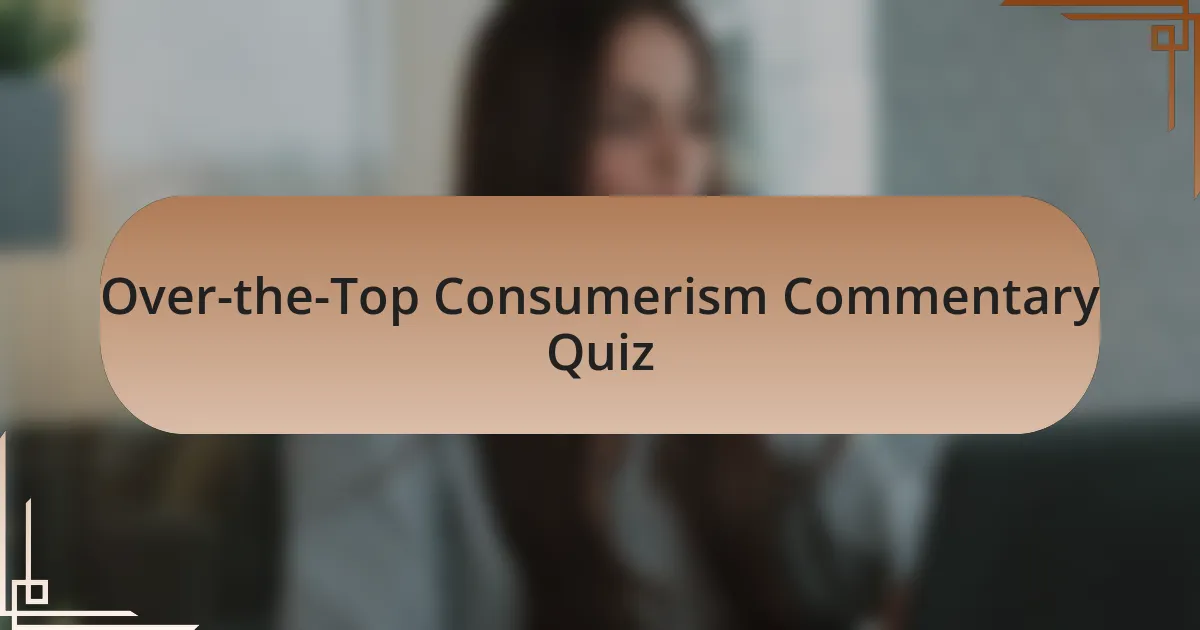Start of Over-the-Top Consumerism Commentary Quiz
1. What is the humorous way to describe consumerism`s impact on our credit card limits?
- My credit card and I play a game of hide and seek; it hides the bills, and I seek more credit!
- My credit card and I are in a committed relationship, and it’s very expensive!
- My credit card has turned into a loyal pet that needs constant feeding!
- My credit card is like a magician; it makes my money disappear!
2. How do advertisements make us think we can buy happiness on a budget?
- Advertisements make us think happiness is found in nature experiences rather than material goods.
- Advertisements claim happiness is only achievable through education and self-improvement.
- Advertisements show happiness comes from spending time with family instead of shopping.
- Advertisements suggest that happiness can be bought through targeted marketing tactics and appealing visuals.
3. What is the joke about conspicuous consumption at a yoga class?
- Participants must pay a fee just to look at the yoga mats on display.
- The instructor asks everyone to bring their luxury cars to class.
- Everyone competes to wear the heaviest jewelry while meditating.
- Everyone arrives in their overpriced yoga gear but can’t hold a downward dog.
4. Why do people joke that the only thing more outdated than their phone is their idea of planned obsolescence?
- They only have flip phones.
- They ignore all tech advancements.
- They can`t keep up with their phones anymore.
- They believe in ancient technology.
5. How does an unopened online shopping box become a trophy of consumerism?
- It turns into a time capsule of past purchases.
- It gets turned into a home decoration piece.
- It is transformed into a donation for the needy.
- It becomes a trophy for being an enthusiastic buyer.
6. What`s a funny way to express the idea of `keeping up with the Joneses` through inflatable lawn decorations?
- Plastic underachievers
- Deflated dreams
- Inflatable show-offs
- Balloon couch potatoes
7. Why do comedians say that every holiday season should come with a budget planner and a therapist?
- To maximize the number of holiday parties and food waste.
- To manage holiday stress and overspending effectively.
- To accommodate oversized gifts and family feuds.
- To ensure every gift is wrapped in designer paper.
8. What’s the tongue-in-cheek relationship between fast fashion and your closet’s overcrowding?
- Fast fashion fits perfectly while keeping closets empty.
- Fast fashion makes closets crowded with trendy items that go out of style quickly.
- Fast fashion allows room for more shoes without guilt.
- Fast fashion promotes a minimalist lifestyle effortlessly.
9. Why do people liken holiday shopping to a competitive sport in humorous commentary?
- Because it involves fierce competition for the best deals.
- Because shopping is always a peaceful activity.
- Because gift-wrapping is an Olympic event.
- Because everyone enjoys the outdoors during winter.
10. How does a meme about “just one more gadget” poke fun at consumer obsession?
- It suggests that people only need one gadget to be happy.
- It indicates that buying gadgets is a form of exercise.
- It claims that gadgets can replace genuine friendships.
- It humorously highlights how insatiable the desire for new gadgets can become.
11. What’s the light-hearted take on online shopping being the ultimate form of procrastination?
- Online shopping is only for grocery items and essentials.
- Online shopping is a sport where you buy things you don’t need.
- Online shopping is a form of competitive eating with discounts.
- Online shopping is a serious task involving extensive planning.
12. How do jokes about `retail therapy` highlight an ironic solution to stress?
- They highlight that spending money is never a solution.
- They show how retail shopping can cause more anxiety.
- They suggest laughter is the best remedy for stress.
- They reveal how shopping provides a temporary escape from stress.
13. Why do comedians say Black Friday should come with its own Olympic event?
- Because of the chaotic stampede for deals.
- Because the prices fall like a comedy sketch.
- Because everyone loves a good discount joke.
- Because shopping makes for a great stand-up routine.
14. What`s humorous about buying a gym membership only to keep the receipt as a fashion statement?
- It`s a witty commentary on consumer culture.
- It shows a love for gym equipment.
- It emphasizes physical fitness goals.
- It reflects on being frugal with purchases.
15. How do parenting blogs humorously illustrate the absurdity of kids’ toy expectations?
- Parenting blogs humorously depict kids excitedly unboxing elaborate toys only to play with the box instead.
- Parenting blogs illustrate that kids only want educational toys and nothing else.
- Parenting blogs show kids receiving toys that are always completely assembled and ready to play.
- Parenting blogs suggest that kids are perfectly satisfied with the toys they receive every time.
16. What’s the gag about a minimalist trying to declutter amidst consumerism pressures?
- The punchline involves the minimalist buying tons of junk.
- The humor lies in the minimalist hoarding everything they own.
- The joke is that the minimalist ends up with one very expensive item.
- The gag focuses on the minimalist investing in a giant storage unit.
17. How do comedians refer to `planned obsolescence` as a relationship with your smartphone?
- App divorce
- Smartphone safari
- Text-and-ghost
- Relationship reset
18. Why do memes about empty wallets after a shopping spree get laughs?
- They highlight the humor in overspending.
- They depict the thrill of online shopping.
- They promote the joy of saving money.
- They suggest buying more luxury items.
19. How do fashion faux pas serve as comedic commentary on consumer pressure?
- Fashion faux pas celebrate individual styles, encouraging everyone to dress as oddly as they like.
- Fashion faux pas suggest that high-priced clothing only needs to be seen, not worn, for popularity.
- Fashion faux pas show how clever advertising can make any outfit seem desirable and fashionable.
- Fashion faux pas highlight the absurdity of trends and societal expectations, making people laugh at the pressures to conform.
20. What`s a humorous observation made about the irony of buying organic dog treats?
- It`s ironic that we buy organic dog treats for dogs who eat trash.
- It`s funny that dogs will only eat treats made from locally sourced ingredients.
- It`s surprising that dogs prefer gourmet treats over basic kibble.
- It`s amusing that dogs see a difference between organic and non-organic treats.
21. Why do jokes about influencer culture highlight the ridiculousness of branded merchandise?
- They promote the idea of sharing products more freely.
- They advocate for minimalism and living simply.
- They encourage people from different cultures to collaborate.
- They show how silly it is to buy things just because a celebrity says so.
22. What’s the comedic twist on a family`s tendency to `just buy what we need` that spirals into chaos?
- The Spending Family
- The Penny Pinchers
- The Thrifty Bunch
- The Budget Holders
23. How do product placement gags in sitcoms exemplify the folly of modern consumer culture?
- Product placement gags make fun of how much we spend on necessities.
- Product placement gags illustrate the benefits of saving money for the future.
- Product placement gags emphasize the importance of reducing consumption for the planet.
- Product placement gags highlight our obsession with brands in a humorous way.
24. Why do online reviews often have a comedic edge when discussing consumer electronics?
- They encourage conspiracy theories about manufacturers.
- They aim to trick consumers into buying more gadgets.
- They highlight the struggles of tech support teams.
- They provide humor to cope with dissatisfaction.
25. How does a humorous take on subscription boxes illustrate our need for novelty?
- Humorous subscription boxes sell old socks and broken toys.
- Humorous subscription boxes make people crave surprises and excitement.
- Humorous subscription boxes never deliver anything funny.
- Humorous subscription boxes offer only food items.
26. What`s a funny analogy about diet fads and the relentless cycle of consumerism?
- Diet fads are like the latest phone model: everyone buys in, then a week later, we’re all upgrading to the next big thing.
- Diet fads are like shoes that never fit: you keep trying them on, but they never feel right.
- Diet fads are like old newspapers: once you`ve read them, they`re just recycled.
- Diet fads are like a one-hit wonder: popular for a moment, then nobody remembers it.
27. How does the gag about overstuffed landfills serve as a comedic reminder of consumer habits?
- It implies that people are careful with their purchases and rarely waste anything.
- It humorously exaggerates our wastefulness and reflects our insatiable need for more stuff.
- It makes us laugh at how clean and efficient our disposal systems are.
- It suggests that landfills are actually places of luxury for old products.
28. What`s the joke about every new pair of shoes being `just what I needed`?
- It means they need more closet space.
- It shows they can`t remember what they own.
- It indicates they have a shoe addiction.
- It`s a clever way to justify impulse buys.
29. Why do comedians joke about the irony of purchasing eco-friendly products just for the packaging?
- It allows them to recycle bad jokes easily.
- It helps them sell more plastic than they need.
- It highlights the paradox of buying green while trashing the earth.
- It keeps landfills less eco-friendly for laughter.
30. What`s the humor in comparing consumerism to a never-ending treadmill?
- It implies that shopping is just a fun exercise with no real consequences.
- It suggests that consumers are stuck in a cycle of endless spending without real progress.
- It means that consumerism helps people stay fit by making them walk.
- It indicates that consumers are running towards something they can never catch.
Congratulations on Completing the Quiz!
Well done on wrapping up our quiz about Over-the-Top Consumerism Commentary! We hope you had a blast navigating through the absurdities of modern shopping trends. From the outrageous to the outrageous-er, it’s clear that consumer culture offers endless material for laughter and reflection.
As you tackled the questions, you might have discovered some surprising insights. Perhaps you learned about the lengths people go to for the latest gadget or the strange fashion statements made in the name of style. Each question was designed to tickle your funny bone while making you ponder the sometimes ridiculous nature of our spending habits.
We invite you to check out our next section. It’s packed with amusing anecdotes, eye-opening statistics, and more depth on Over-the-Top Consumerism. Expand your knowledge and get ready for belly laughs as we explore this quirky aspect of life further. Dive in; the fun doesn’t have to stop here!
Over-the-Top Consumerism Commentary
The Absurdity of Daily Deals and Discounts
Over-the-top consumerism often manifests in the form of relentless promotions. Daily deals create an urgency that tricks people into buying items they don’t need. The humor lies in the irony of purchasing expired items or ridiculous gadgets because they’re “on sale.” Shopping becomes less about need and more about a fleeting sense of satisfaction.
Subscription Services Gone Wild
Many consumers now pay for multiple subscription services that deliver everything from food to beauty products. The humor emerges when people realize they’re subscribed to ten services, but still can’t cook a decent meal. It highlights the absurdity of paying monthly for convenience while juggling multiple boxes at their doorstep.
The Competition for Outrageous Buying Experiences
Modern consumer culture drives individuals to seek increasingly extravagant experiences. Whether it’s a $2,000 dinner or a designer yoga class, the race for the most notable purchase becomes comedic when one realizes these experiences often provide minimal value. It ironically showcases how far people will go to impress others.
Gimmicky Products That Are Too Much
The market is filled with bizarre products designed to solve non-issues. Items like avocado slicers or heated butter dispensers exemplify the extremes of consumerism. The humor is in their impracticality and the reality that they clutter kitchens, serving no real purpose other than to elicit laughter.
Social Media’s Role in Consumer Pressure
Social media amplifies consumer pressure through curated lifestyles and influencer marketing. The humor lies in the crafted perfection of influencers hawking lavish purchases that aren’t attainable for most. This disconnect often leads to absurd spending by followers trying to replicate an illusion, revealing the ridiculousness of the chase for status symbols.
What is Over-the-Top Consumerism Commentary?
Over-the-Top Consumerism Commentary refers to exaggerated or humorous critiques of consumer culture. This commentary often highlights the absurdity of excessive spending and materialism in society. It employs satire to poke fun at how consumerism influences lifestyle choices and personal values, showcasing how individuals prioritize possessions over genuine experiences. Such commentary often reflects societal trends where the quest for status and wealth supersedes more meaningful pursuits.
How does Humor enhance Over-the-Top Consumerism Commentary?
Humor enhances Over-the-Top Consumerism Commentary by making serious critiques more approachable and engaging. It provides a vehicle to address uncomfortable truths about materialism in a palatable manner. For instance, satirical portrayals of absurd consumer habits can provoke thought while entertaining the audience. Comedians often use irony and exaggeration to illustrate the pitfalls of consumer culture, encouraging reflection on societal norms without alienating the audience.
Where can you find examples of Over-the-Top Consumerism Commentary?
Examples of Over-the-Top Consumerism Commentary can be found in various media, including social media platforms, comedy shows, and satirical publications. Shows like “The Daily Show” and “Saturday Night Live” frequently include sketches that critique consumer behavior. Additionally, platforms such as Twitter and Instagram host memes and posts that humorously address contemporary consumer excesses, making them accessible to a wider audience.
When did Over-the-Top Consumerism Commentary become popular?
Over-the-Top Consumerism Commentary gained popularity in the late 20th century, particularly during the economic boom of the 1980s. This era saw a rise in consumer goods and advertising, prompting satirical responses from comedians and writers. The advent of the internet in the 2000s further accelerated this trend, allowing for rapid dissemination of humorous critiques on social media. As consumerism intensified in the 21st century, the commentary became even more prominent.
Who are notable figures in Over-the-Top Consumerism Commentary?
Notable figures in Over-the-Top Consumerism Commentary include comedians like George Carlin and Louis C.K., who frequently explore themes of consumerism in their routines. Authors like Chuck Palahniuk, particularly in “Fight Club,” critique material culture through narrative satire. Additionally, satirical media outlets like The Onion and websites like Cracked have produced significant commentary that humorously addresses consumer behavior and its repercussions.


